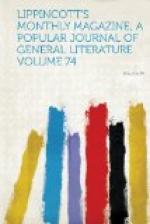A pretty romance is associated with the discovery and naming of Van Diemen’s Land. A young man, Tasman by name, who had been scornfully rejected by a Dutch nabob as the suitor of his daughter, resolved to prove himself worthy of the lady of his heart. So, while his inamorata was cruelly imprisoned in the palace of her sire at Batavia, young Tasman, instead of wasting time in regrets, set forth on a voyage of adventure, seeking to win by prowess what gallantry had failed to effect. On his first voyage he so far circumnavigated the island as to be convinced of its insular character, but really saw little of the land. In subsequent voyages he made extensive explorations, calling not only the mainland, but all the little islets he discovered, by the several names and synonyms of Mademoiselle Van Diemen, his beloved. When at length he was able to lay before the Dutch government the charts of his voyages and a digest of his discoveries in the beautiful land where he had already planted the standard of Holland, the cruel sire relented and consented to receive as a son-in-law the successful adventurer. Tasman, it seems, never very fully explored the waters that surrounded his domain, and the honor was reserved to two young men, Flinders and Bass, of discovering in 1797 the deep, wide strait of two hundred and seventy miles in width that bears the name of Bass. The scenery of Van Diemen’s Land is full of picturesque beauty—a sort of miniature Switzerland, with snow-clad peaks, rocks and ravines, foaming cataracts and multitudinous little lakes with their circling belt of green and dancing rivulets bordered with flowers. The Valley of Launceston is a very Arcadia of pastoral repose, while the Tamar—which in its whole course is rather a succession of beautiful lakes than an ordinary river—with its narrow defiles, basaltic rocks and sparkling cataracts, picturesque rocks that cut off one lake and suddenly reveal another, is a very miracle of beauty, dancing, frothing, foaming, like some playful sprite possessed with the very spirit of mischief.
[Illustration: Hobart town.]




